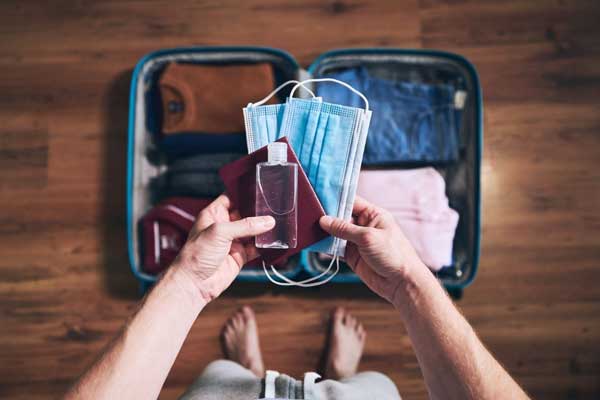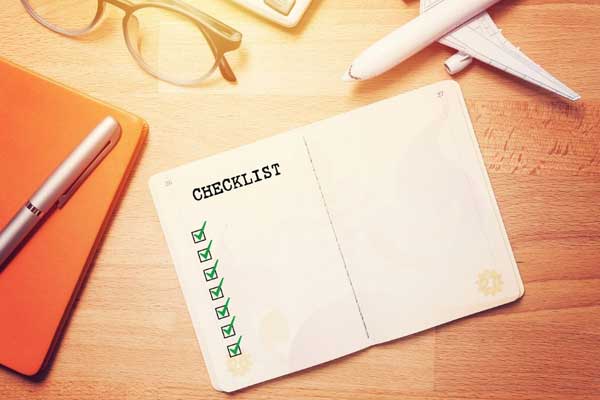As the world slowly opens up and we yearn to travel again, the first thing to consider before you book that getaway is your own health. With travel comes risk for exposure to the COVID-19 virus, and good underlying health means a safer journey. We asked Shane McCarthy D.O., who has over 20 years’ experience as a primary care physician, for advice and tips to help you travel safely in the future.
When traveling overseas, what are the requirements for entry?

Pre-COVID, all you needed was a passport. Nowadays, the list is much longer—and different for each destination. Conditions for tourist entry are country specific and may include: Proof of vaccination status; documented negative COVID test within a certain timeframe prior to arrival; certification of international medical insurance coverage— which may need to specify trip dates, set dollar amounts (e.g., coverage up to U.S. $50,000), and other funding minimums to cover medical costs, food, and housing in case of quarantine; health forms and attestations; and self-quarantine and/or retesting after arrival.
Find a list of specific requirements at your destination country’s U.S. Embassy website. If you are traveling to more than one country or region, you will need to meet the requirements for each location.
Is public transportation safe?

A few COVID-safe guidelines apply to all public transportation: wear a properly fitting mask, socially distance as much as possible, don’t eat or drink en route, and, when possible, open a window to increase ventilation.
What about flying?
Excellent air circulation and HEPA filtration on airplanes means it is not as risky as it sounds. Unlike most other indoor spaces, an airplane cabin’s air is replaced every two to three minutes. Fresh air is mixed with recirculated air that was passed through HEPA filters, which remove >99% of infectious particles. So even though you can’t open a window, ventilation is achieved.
As airports become more crowded and middle seats on flights are being sold again, distancing on your trip may be increasingly difficult. Do what you can. When there is extra space, spread out. When you need to eat and drink, do so quickly. Bring an eco-friendly straw or a water bottle with a pop-up straw that you can slip under your mask for safer sipping. Sneak a snack—piece by piece—under your mask to eat while it remains on.
Is it safe to go on a cruise?

Many ship lines are now overhauling ventilation systems, so cruises should be safer when they are given the green light to set sail. But beware—cruises are not likely to be considered a “safe” option for travel anytime soon. The fact that cruise ships carry thousands of passengers at a time, in a mostly enclosed space, means the risk for transmission of infection is higher than in other types of travel.
If you decide to cruise, do your research. Check vaccination and COVID testing policies for passengers and crew. Are numbers of passengers limited to allow for social distancing? What about masking policies and practices? And you’ll want specific information on the ship’s ventilation system before you book.
Where should I stay?
You’ll want to stay in a space where you can let down your guard and relax a little. And if it’s not obvious by now, accommodations where you can keep your distance from other travelers—like vacation rental homes—are your safest bet. But when that’s not an option… Are hotels OK? What about a B&B? Can you safely stay with friends or family?
There are pros and cons to consider for each situation before you book. As you weigh alternatives, make sure to reserve accommodations that provide quarantine space, in case someone in the group becomes ill. And think about where you would stay if you had to extend your trip by two to three weeks for quarantining.

Get Your Free Report on the World’s Best Places to Retire:
Learn more about the best places in the world to retire in our daily postcard e-letter.
Simply enter your email address below to sign up for our free daily postcards and we’ll also send you a FREE report on The World’s Top 10 Retirement Havens, plus access to over 10 more free reports. Our gift to you, on our favorite destinations.
Your Pre-Travel Checklist

With so many more considerations and requirements for post-pandemic travel, in a special extended “Ask the Expertˮ this issue, she provides a detailed to-do list of what you should do before you travel.
First Things First
- Get Vaccinated with an FDA-approved COVID-19 vaccine. Keep proof of your vaccine—make copies of the card or take a picture. If you live in a state that logs your vaccines electronically or has vaccine passports, keep the link and/or download the app.
- List COVID-specific requirements for your destination. Which documents do you need to present upon arrival? Pre-travel COVID test results? Proof of vaccination? Anything else? Be sure to check requirements for each leg of your trip, as they can vary.
- List COVID-specific requirements for returning home. Do you need proof of a negative COVID test prior to boarding your plane back to the U.S.? Check CDC and State Department websites for the most up-to-date requirements. If you plan to stay in a small town or village, COVID testing may not be available. Plan extra days to get tested.
- List further testing and self-quarantine requirements. Some destinations may require self-quarantining and/or further testing upon arrival. Check the U.S. embassy and local tourist board websites for each leg of your trip. You may also need to self-quarantine and/or get tested upon returning home. Check with local authorities.
- Make a list of additional travel recommendations for your destination. Country and region-specific suggestions can be found on the CDC website.
At Booking Time
- Book your airline and local travel tickets as well as accommodations for the entire trip.
- Check cancellation policies for all bookings.
- Consider paying extra for refundable/transferrable tickets and Trip Cancellation Insurance. In this post-pandemic world of uncertainty, trip cancellation insurance is advisable. Look specifically at COVID-19 related cancellation wording in the policy.
- Get Travel Health Insurance/ International Medical Insurance. Check with your U.S. health insurance provider to see if they cover you abroad in case of emergency. Even if they do, a destination country may require you to purchase an international medical insurance policy for your travel dates and present certification at the time of entry. If staying in a remote area, check if your policy includes medical evacuation coverage. If not, this can be purchased separately.
Months Before
- Establish an emergency contact at home, including the best way to reach them and fellow travelers while abroad.
- Fill out forms required by your destination. Check timing—some forms must be dated closer to departure—and whether they need to be notarized.
- Schedule a visit to your doctor. Bring any health forms or certifications requiring a physician’s signature and update your routine and travel vaccinations. You can research destination specific prescription needs at the CDC website (e.g., malaria prophylaxis).
- Make medication changes. Any changes to daily medications should be made well in advance of departure. At departure, you’ll need to have enough pills to last the duration of travel, plus two to three weeks in case of quarantine.
- Exercise, eat right, and sleep well. The healthier you are at departure, the lower your risk of becoming ill on the trip
Weeks Before
- Double check guidelines and requirements, including on the CDC and U.S. embassy websites as well as airline and hotel/accommodation sources for updates or changes in requirements.
- Register with the State Department’s Smart Traveler Enrollment Program (STEP) to receive health and travel alerts.
- Create a document with your health information. Include your medical diagnoses, all prescriptions and over-the-counter medications, contact numbers for fellow travelers, local accommodations, and your emergency contact back home.
- Pick up prescriptions including extra in case of quarantine.
- Learn key words in your destinations language, such as “mask,” “vaccine,” and “viral test.”
- Read the news from the region to monitor outbreaks and restrictions.
- Plan and shop. If you are planning more outdoor activities than you normally would, carefully consider what you’ll need for each: shoes, raincoats, sunscreen, etc.
Days Before
In the days before you leave, be sure to:
- Get mandatory COVID-19 viral testing if required by your destination country.
- Pack, including anything extra you would need for a two- or three-week quarantine.
- Take pictures of your passport, COVID-19 vaccination card, and COVID-19 test results.
- Find phone numbers for local doctors, hospitals, and emergency care in your destination city.
- Take extra care to stay safe—now is not the time to get sick.

Get Your Free Report on the World’s Best Places to Retire:
Learn more about the best places in the world to retire in our daily postcard e-letter.
Simply enter your email address below to sign up for our free daily postcards and we’ll also send you a FREE report on The World’s Top 10 Retirement Havens, plus access to over 10 more free reports. Our gift to you, on our favorite destinations.
Related Articles
The World’s Best Places to Retire
5 Great Places to Retire Where it’s Easy to Fit In
Everything You Need to Know About Medicare Overseas
Upcoming Conferences
The Only 2024 Fast Track Panama Conference
If your dream retirement involves stunning beaches… lush green mountains… a warm climate with no hurricanes… first-rate healthcare… incredible value for money (a couple can live well on $2,200 a month)… and the World’s #1 Retiree Discount Program…
Join our Panama experts and expats in February and discover why Panama could be your perfect paradise.
REGISTER NOW, SEATS LIMITED: EARLY BIRD DISCOUNT HERE



.png)